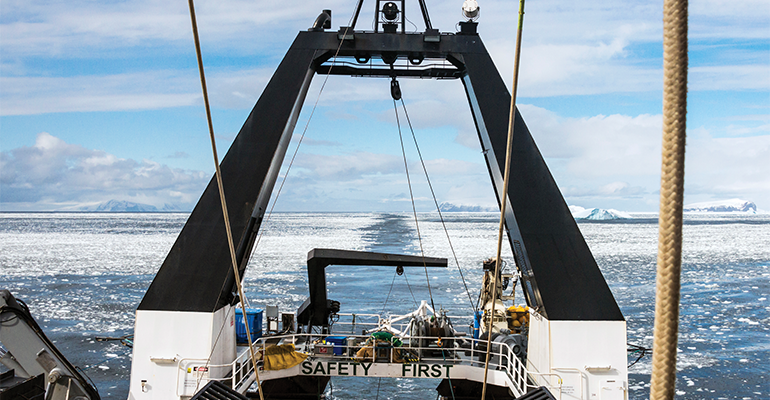- Earth System Modelling & Prediction
Research Programme
- Inga Smith
University of Otago - Max Thomas
University of Otago - Shona Mackie
University of Otago - Andrew Pauling
University of Otago - View the full team
Project Leaders
-
Budget
$840,000 -
Duration
July 2017 – June 2024
-
Completed project
Modelling Antarctic Sea Ice
Sea ice is a critical part of our climate system, reflecting solar energy back into our atmosphere, and is instrumental in the generation of storms that alter our weather. Sea ice in turn is influenced by fresh water melt from ice shelves, which both is poorly understood and poorly represented in global climate models.

Using the NZESM and data from other global models, this project investigated persistence and reversibility of the sea ice response to increased freshwater melt and other anthropogenic climate drivers in the Southern Ocean, and improved the model code to better represent ice shelf melt.
Key findings:
- Traditional climate models often use very simple representations of ice shelf melt that do not vary in space or time. By exploring more realistic spatial distributions of melt and explicit inclusion of icebergs in the NZESM, and comparing this to other less complex models, this project has provided insights into processes that influence the behaviour of sea ice and oceans around Antarctica.
- Code has been developed to incorporate regionally-specific observations of ice shelf melt, into the ocean model within the NZESM. This is significant, as it cannot otherwise be done without the huge computational expense of coupling an ice shelf model.
In the media:
- New Zealand’s Next Top Model, New Zealand Geographic
- Breaking the ice, NIWA
Research stages:
Antarctic ice-mass loss climate impacts: 2023 – 2024
Budget: $180,000
We quantified the climate impacts from increasing Antarctic ice-mass loss in a suite of Global Climate Models, focusing our analysis on New Zealand impacts.
Antarctic ice-mass loss from ice sheets and shelves is increasing and is projected to increase further. Though this increase is expected to impact climate, it is absent from all models in the current Climate Model Intercomparison Project (CMIP6) and the New Zealand Earth System Model (NZESM). Further, non-CMIP6 model experiments with varying Antarctic ice-mass loss suggest that the response to Antarctic ice-mass loss depends on the model used, and the reasons for this model dependence are not clear. Taken together, the absence of a key process from the CMIP6 ensemble and the discrepancies between models that include this process hamper New Zealand’s ability to anticipate climate change.
We used the physical core of the NZESM to contribute experiments with additional Antarctic ice-mass loss to an international model intercomparison. This unique suite of models will allow us to evaluate the core against several other climate models, identify reasons for model discrepancies, and quantify the potential impact of the absence of increasing Antarctic ice-mass loss on climate modelling for New Zealand.
Sea ice modelling for NZESM development: 2019 – 2022
Budget: $360,000
We sought to make improvements to sea ice representation in the NZESM available to all NZESM users, through porting code to the NeSI supercomputer Maui. Similarly, shared improved flexibility in the NZESM’s ocean component. This significant work made the NZESM straightforward for any authorised user to run.
In our first phase, we investigated the impacts of freshwater melt from icebergs and ice shelves that occur in a warming world. We simulated these impacts by artificially increasing the meltwater input to the Southern Ocean in the NZESM. We used fixed pre-industrial forcings, and then ‘idealised’ forcings to see how responses would change under different warming scenarios. We continued this line of research, to determine persistence (or reversibility). We analysed fresh water impacts on sea ice extent and ocean surface properties, both of which could have implications for New Zealand’s future climate, as well as the climate of countries further from the sea ice.
We further determined whether the climate-related responses we found under idealised conditions hold up in a more realistic setting, when the meltwater input occurs simultaneously with realistic changes in greenhouse gases, stratospheric ozone, and other anthropogenic climate forcings.
Our aim was to ensure that the NZESM can be a ‘ready to use’ tool capable of calculating updated climate projections as new estimates of mass loss rates from specific ice shelves become available. It will be suitable for research into the potential impacts of regionally-specific mass loss acceleration, making it possible to identify areas to target future observation effort.
Lastly, this flexibility made the representation of ice shelf melt more realistic in the NZESM, by using up-to-date observations to account for spatial and temporal variability in melt rates, without the expense of coupling a dynamic ice sheet model.
Melting ice in the NZESM: 2017 – 2020
Budget: $300,000
Changes in Antarctic sea ice can have a huge effect on weather patterns over New Zealand, causing varying wind patterns that lead to cyclones, increased rainfall and abnormal temperatures. In addition, the amount of Antarctic sea ice affects the global climate, by influencing the heat uptake of the Southern Ocean – one of the world’s largest carbon sinks.
Current climate models have been unable to replicate the increase in Antarctic sea ice. Through model development and improvements, this project investigated if the recent increase in Antarctic sea ice is being influenced by freshwater from melting icebergs or from the bases of Antarctic ice shelves.
Our early research informed the development of the NZ Earth System Model.
Antarctic sea ice: 2015 – 2021
This modelling is built on research into the targeted observation and process-informed modelling of Antarctic sea ice (TOPIMASI). Read more about that project here.
PROJECT TEAM
-
Inga Smith
University of Otago -
Cecilia Bitz
University of Washington -
Jeff Ridley
Met Office Hadley Centre -
David Stevens
University of East Anglia -
Shona Mackie
University of Otago -
Torge Martin
GEOMAR Helmholtz Centre for Ocean Research Kiel -
Max Thomas
University of Otago -
Andrew Pauling
University of Otago